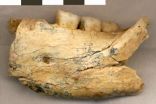(Press-News.org) In the evening of Feb. 5, 2013, the sun erupted with two coronal mass ejections or CMEs that may glance near-Earth space. Experimental NASA research models, based on observations from the Solar Terrestrial Relations Observatory (STEREO) and ESA/NASA's Solar and Heliospheric Observatory, show that the first CME began at 7 p.m. EST and left the sun at speeds of around 750 miles per second. The second CME began at 10:36 p.m. EST and left the sun at speeds of around 350 miles per second. Historically, CMEs of this speed and direction have been benign.
Not to be confused with a solar flare, a CME is a solar phenomenon that can send solar particles into space and reach Earth one to three days later.
VIDEO:
Solar material can be seen blowing off the sun in this video captured by NASA’s Solar Dynamics Observatory on the night of Feb. 5, 2013. This active region on the...
Click here for more information.
Earth-directed CMEs can cause a space weather phenomenon called a geomagnetic storm, which occurs when they connect with the outside of the Earth's magnetic envelope, the magnetosphere, for an extended period of time. In the past, CMEs at this strength have had little effect. They may cause auroras near the poles but are unlikely to disrupt electrical systems on Earth or interfere with GPS or satellite-based communications systems.
INFORMATION:
NOAA's Space Weather Prediction Center is the United States Government official source for space weather forecasts, alerts, watches and warnings.
NASA sees the sun produce 2 CMEs
2013-02-07
ELSE PRESS RELEASES FROM THIS DATE:
Animal magnetism: First evidence that magnetism helps salmon find home
2013-02-07
When migrating, sockeye salmon typically swim up to 4,000 miles into the ocean and then, years later, navigate back to the upstream reaches of the rivers in which they were born to spawn their young. Scientists, the fishing community and lay people have long wondered how salmon find their way to their home rivers over such epic distances.
How do they do that?
A new study, published in this week's issue of Current Biology and partly funded by the National Science Foundation, suggests that salmon find their home rivers by sensing the rivers' unique magnetic signature. ...
NASA scientists build first-ever wide-field X-ray imager
2013-02-07
Three NASA scientists teamed up to develop and demonstrate NASA's first wide-field-of-view soft X-ray camera for studying "charge exchange," a poorly understood phenomenon that occurs when the solar wind collides with Earth's exosphere and neutral gas in interplanetary space.
The unique collaboration involved heliophysics, astrophysics and planetary science divisions at NASA's Goddard Space Flight Center in Greenbelt, Md., and resulted in the first successful demonstration of the Sheath Transport Observer for the Redistribution of Mass (STORM) instrument and a never-before-flown ...
Same factors influence depression in stroke patients, spouse caregivers
2013-02-07
Self-esteem, optimism and perceived control influence depression in stroke survivors and their spouse caregivers — who should be treated together, according to research presented at the American Stroke Association's International Stroke Conference 2013.
Researchers, who analyzed 112 depressed stroke survivors up to 8 weeks after hospital discharge and their spouses, found self-esteem and optimism influenced each partners' depression.
"We usually have been focused on the outcome of the stroke survivor, but we found that the self-esteem and optimism of the spouse caretaker ...
Study: Number of people with Alzheimer's disease may triple by 2050
2013-02-07
MINNEAPOLIS – The number of people with Alzheimer's disease is expected to triple in the next 40 years, according to a new study published in the February 6, 2013, online issue of Neurology®, the medical journal of the American Academy of Neurology.
"This increase is due to an aging baby boom generation. It will place a huge burden on society, disabling more people who develop the disease, challenging their caregivers, and straining medical and social safety nets," said co-author Jennifer Weuve, MPH, ScD, assistant professor of medicine, Rush Institute for Healthy Aging ...
Can nerve stimulation help prevent migraine?
2013-02-07
MINNEAPOLIS – Wearing a nerve stimulator for 20 minutes a day may be a new option for migraine sufferers, according to new research published in the February 6, 2013, online issue of Neurology®, the medical journal of the American Academy of Neurology.
The stimulator is placed on the forehead, and it delivers electrical stimulation to the supraorbital nerve.
For the study, 67 people who had an average of four migraine attacks per month were followed for one month with no treatment. Then they received either the stimulation 20 minutes a day for three months or sham ...
'Listening to your heart' could improve body image, says study
2013-02-07
Women who are more aware of their bodies from within are less likely to think of their bodies principally as objects, according to research published February 6 in the open access journal PLOS ONE by Vivien Ainley and Manos Tsakiris from the Department of Psychology at Royal Holloway, University of London.
The authors asked healthy female student volunteers aged between 19 – 26 to concentrate and count their own heartbeats, simply by "listening" to their bodies. Their accuracy in this heartbeat perception test was compared with their degree of self-objectification, based ...
Despite reported dislike, older readers put in less effort when using e-readers
2013-02-07
Reading text on digital devices like tablet computers requires less effort from older adults than reading on paper, according to research published February 6 in the open access journal PLOS ONE by Matthias Schlesewsky and colleagues from Johannes Gutenberg University Mainz, Germany, in collaboration with colleagues from Georg August University Göttingen and the University of Marburg, Germany.
In the past, surveys have shown that people prefer to read paper books rather than on e-readers or tablet computers. Here, the authors evaluated the origins of this preference in ...
Features of southeast European human ancestors influenced by lack of episodic glaciations
2013-02-07
A fragment of human lower jaw recovered from a Serbian cave is the oldest human ancestor found in this part of Europe, who probably evolved under different conditions than populations that inhabited more western parts of the continent at the same time, according to research published February 6 in the open access journal PLOS ONE by William Jack Rink of McMaster University, Canada, and the international team under the direction of Dušan Mihailović, University of Belgrade, Serbia, and Mirjana Roksandic, University of Winnipeg, Canada.
The fossil was found to be ...
Antibiotic cream has high cure rate, few side effects in treating cutaneous leishmaniasis
2013-02-07
Fort Detrick, Md. – An international collaboration of researchers from the U.S. Army Medical Research and Materiel Command (USAMRMC), Tunisia and France has demonstrated a high cure rate and remarkably few side effects in treating patients with cutaneous leishmaniasis (CL) with an investigational antibiotic cream. CL is a parasitic disease that causes disfiguring lesions, with 350 million people at risk worldwide and 1.5 million new cases annually, including U.S. military personnel serving abroad and the socio-economically disadvantaged in the developing world, especially ...
Lungs of the planet reveal their true sensitivity to global warming
2013-02-07
Tropical rainforests are often called the "lungs of the planet" because they generally draw in carbon dioxide and breathe out oxygen. But the amount of carbon dioxide that rainforests absorb, or produce, varies hugely with year-to-year variations in the climate. In a paper published online this week (Feb 6 2013) by the journal Nature, a team of climate scientists from the University of Exeter, the Met Office-Hadley Centre and the NERC Centre for Ecology & Hydrology, has shown that these variations reveal how vulnerable the rainforest is to climate change.
Lead author ...



